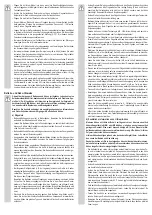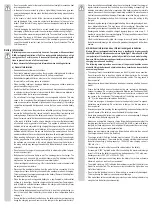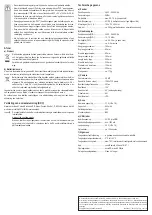
•
Do not expose the model or the remote control to direct sunlight or excessive heat
for prolonged periods.
•
In the event of a severe crash (e.g. from a high altitude), the electronic gyro sen-
sors may be damaged. Always check that the model is functioning properly before
flying it again!
•
In the event of a crash, switch off the rotor motors immediately. Rotating rotors
may be damaged if they come into contact with obstacles or in the event of an
impact. Check the rotors for any signs of cracks or damage before flying the quad
-
copter again!
•
To avoid damaging the model due to a crash caused by an undervoltage/over-
discharging of the battery, monitor the undervoltage indicators during the flight.
•
Do not exceed the maximum range stated in the “Technical data” section of these
instructions. The range is 50% lower when the quadcopter is controlled with a
smartphone instead of the remote control. If the quadcopter goes out of range,
you will not be able to control it and it will continue to fly until it crashes! This will
void the warranty.
Battery information
Batteries present numerous safety hazards. Compared with conventional
NiMH rechargeable batteries, LiPo/Li-ion rechargeable batteries have a high
energy content. For this reason, it is essential to comply with safety regula-
tions to prevent the risk of a fire or explosion.
Always observe the following safety information when handling batteries.
a) General information
•
Keep batteries out of the reach of children.
•
Do not leave batteries lying around, as they present a choking hazard for children
and pets. Seek immediate medical advice if a battery is swallowed.
•
Batteries/rechargeable batteries must never be short-circuited, taken apart or
thrown into fire, as this may cause an explosion!
•
When handling leaking or damaged batteries, always use suitable protective
gloves to avoid burning your skin.
•
Liquids that leak from batteries are very corrosive and may cause serious damage
to objects or surfaces that come into contact with them. Always store batteries in
a suitable location that is not prone to damage.
•
Do not attempt to recharge disposable, non-rechargeable batteries. This may
cause a fire or explosion! Non-rechargeable batteries are only designed to be
used once and must be disposed of properly when they are empty. Only recharge
compatible rechargeable batteries and ensure that you use a suitable battery
charger.
•
If you do not plan to use the model for an extended period (e.g. during storage),
remove the batteries from the remote control to prevent them from leaking and
causing damage. Disconnect the battery and remove it from the model.
Keep the remote control batteries and quadcopter battery in a cool, dry place out
of the reach of children. Install a smoke detector in the room. Batteries present
a fire hazard and may generate toxic fumes. This applies in particular to model
batteries, which are subjected to high charging/discharge currents and vibrations.
•
Always exchange the entire set of batteries in the remote control. Do not mix full
batteries with half-full ones. Always use batteries of the same type and from the
same manufacturer. Never mix disposable batteries with rechargeable batteries.
•
When inserting batteries into the remote control or connecting the quadcopter
battery, pay attention to the polarity markings (plus/+ and minus/-) to ensure that
the batteries are connected in the correct polarity. Connecting the batteries in
the wrong polarity may damage the model and the batteries and cause a fire or
explosion!
•
Do not expose the charger or quadcopter battery to extremely high/low tempera-
tures or direct sunlight.
•
Batteries must not become damp or wet. The same applies to the charger. The
charger must only be used in dry, enclosed indoor areas. The quadcopter battery
may cause a fire or explosion if exposed to moisture/liquids!
Lithium rechargeable batteries (e.g. LiPo/Li-ion batteries) contain chemicals that
are very sensitive to moisture.
•
Disconnect the quadcopter battery from the model before connecting it to the
charger. Never leave the battery connected to the quadcopter when it is charging.
This may damage the charger, quadcopter or the battery! Remove the battery from
the quadcopter before charging.
• Place the charger and rechargeable battery on a non-flammable, heat-resistant
surface (e.g. stone tiles). Keep the charger and battery away from flammable ob
-
jects. Maintain a sufficient distance between the charger and the battery. Never
place the battery on top of the charger.
•
Do not charge batteries when they are still hot (e.g. due to a high discharge cur-
rent in the model). Allow the battery to cool down to room temperature before
charging it.
• Ensure that there is sufficient ventilation, as the battery and charger may heat up
during the charging process. Never cover the charger or the quadcopter battery!
•
Never leave batteries unattended when they are charging. Inspect the charger at
regular intervals to ensure that the battery is not overheating or expanding. This
indicates an imminent risk of a fire or explosion. If the battery overheats or starts to
expand, disconnect it from the charger immediately and take it to a location where
it will not cause any additional damage if it explodes or catches fire (e.g. outdoors).
•
Disconnect the quadcopter battery from the charger when the battery is fully
charged.
•
Never damage the casing of a rechargeable battery. Never charge damaged, leak-
ing or deformed batteries. This may cause a fire or explosion! Discontinue use
immediately and dispose of the battery in an environmentally friendly manner.
•
Rechargeable batteries should be charged regularly (approx. once every 2 - 3
months) to prevent them from overdischarging. This may result in permanent dam-
age and render the batteries useless.
LiPo/Li-ion batteries usually retain their charge for several months. However, if
the batteries overdischarge, this will result in permanent damage and render them
useless.
b) Additional information about lithium rechargeable batteries
Modern lithium rechargeable batteries have a significantly higher capacity
than NiMH and NiCd batteries and are more lightweight. This makes LiPo (lith-
ium polymer) or Li-ion batteries particularly suitable for use in model making.
However, lithium batteries require particular care to ensure safe charging/dis-
charging, operation and handling.
The following section provides an overview of the potential hazards associ-
ated with lithium batteries and explains how these hazards can be avoided to
ensure a long lifespan.
• The casing of many lithium batteries is made of a thick film, which is very sensitive.
Do not dismantle, drop or insert any objects into lithium batteries. Do not apply
mechanical loads or pull on the battery’s connection cables. This may cause a
fire or explosion!
•
Always observe these instructions when inserting or removing a battery from your
model.
•
Ensure that the battery does not overheat during use, recharging, discharging,
transport or storage. Do not place rechargeable batteries next to sources of heat
or expose them to direct sunlight. This may cause the battery to overheat, which
can cause a fire or explosion! The temperature of the battery must not exceed
+60 °C (or the temperature indicated on the battery).
•
If there are any signs of damage or the outer casing starts to swell or expand,
discontinue use immediately. Do not continue to charge it, as this may cause a
fire or explosion!
•
Exercise caution when handling the damaged battery and use suitable protective
gloves. Dispose of the battery in an environmentally friendly manner.
•
Never store damaged batteries in an apartment or in a house/garage. Damaged
or swollen lithium batteries may catch fire.
•
Always use a compatible charger to charge lithium batteries and ensure that the
charging specifications are correct. Do not use NiCd, NiMH or lead-acid battery
chargers, as these may cause a fire or explosion! Always select the correct charg
-
ing specifications for your rechargeable battery.
•
Always use a balancer when charging a lithium battery with more than one cell
(the charger comes with a built-in balancer).
•
The charge rate for LiPo/Li-ion batteries must not exceed 1C (or the value stated
in the battery instructions). This means that the charging current must not exceed
the battery capacity (e.g. battery capacity = 1000 mAh, max. charging current =
1000 mA = 1 A).
•
The discharge current must not exceed the value stated on the battery.
•
For example, if “20C” is printed on the LiPo/Li-ion battery, the maximum discharge
current is 20 times the battery’s capacity (e.g. battery capacity = 1000 mAh, max.
discharge current = 20C = 20 x 1000 mA = 20 A).
•
Exceeding the maximum current may cause the battery to overheat or become
deformed, which can lead to a fire or explosion!
•
The printed value (e.g. 20C) indicates the maximum current that the battery can
deliver for a short period. The continuous current should not be higher than one
half of the stated value.
•
Do not allow the individual cells of a lithium battery to become fully discharged.
This may destroy the battery or cause permanent damage.
•
If the model does not have overdischarge protection or a low battery indicator, stop
using it before the battery becomes empty.




















